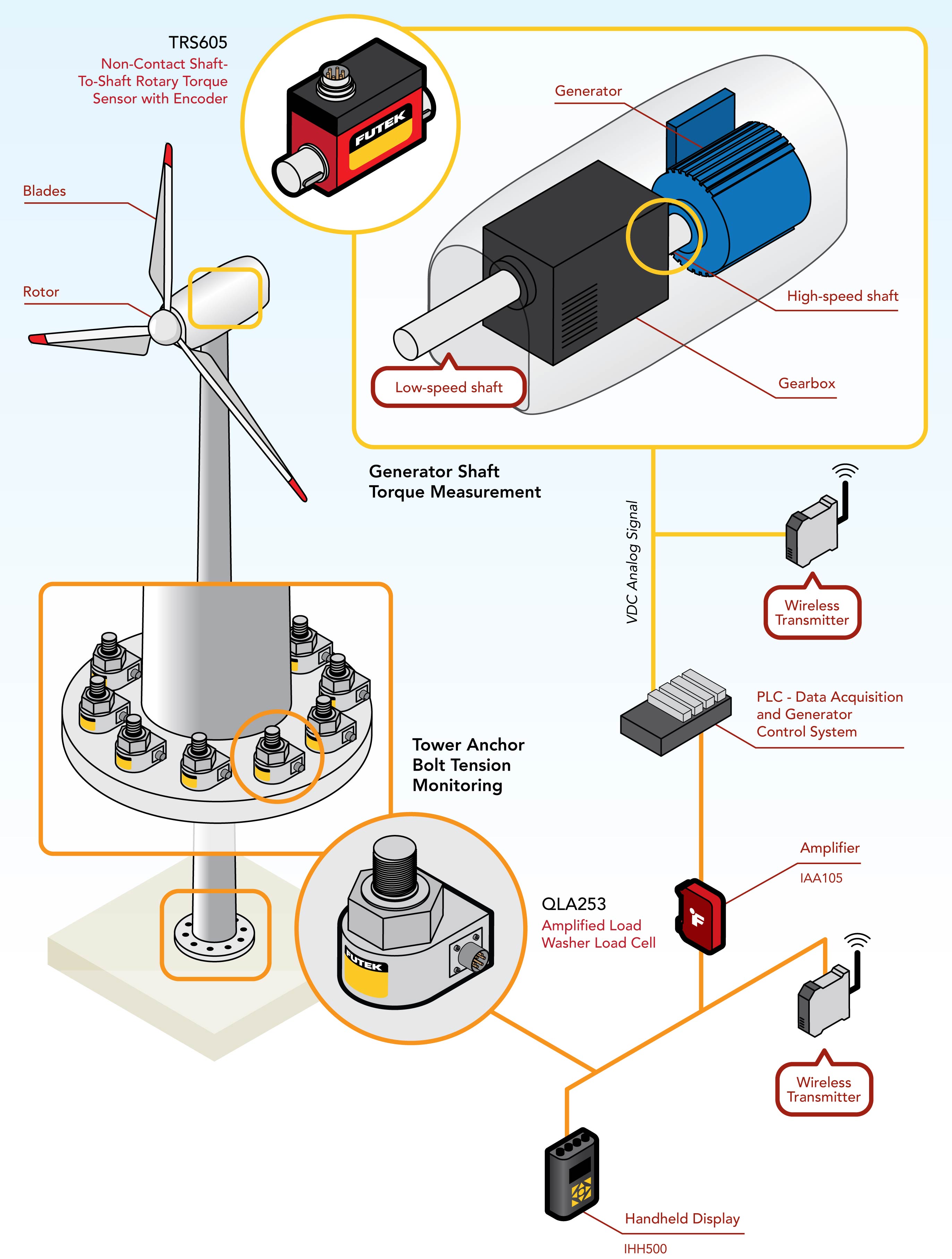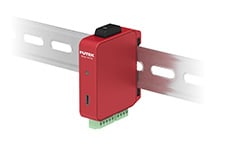Wind Turbine Monitoring
How rotary torque sensors and load cells are utilized in Wind Turbine Control & Monitoring?
In ensuring wind turbines perform at their peak, rotary torque sensors and load cells play a pivotal role in delivering precise readings, ensuring optimal performance and structural integrity through precise generator shaft torque and anchor bolt tension measurements, information crucial for both operational smoothness and structural health of the turbines.
Generator Shaft Torque Measurement
The generator shaft is the backbone of the wind turbine's energy conversion process, where the mechanical energy of the wind is transformed into electrical energy. Rotary torque sensors, or transducers, are employed to accurately monitor the torque exerted on the generator shaft. These devices, particularly non-contact rotary torque sensors that utilize strain gauge technology, offer a unique and precise solution for capturing torque data through non-contact signal transfer resulting in higher durability and minimal maintenance.
Tower Anchor Bolt Tension Inspection and Monitoring
The stability of the tower is largely dependent on the tension of the tower anchor bolts, which secure the turbine to its foundation. Environmental factors such as wind speed, direction, and variability, as well as mechanical loads from the turbine operation, can affect the tension of these bolts. Through-hole load cells measure the bolt clamping force, providing real-time data that can be used to assess the structural integrity of the turbine to its base support. Proper tension monitoring helps in preventing the loosening of bolts, which can lead to tower misalignment or, in extreme cases, catastrophic failure.
Why is the FUTEK TRS605 torque sensor and QLA253 load cell suitable for Wind Turbine Monitoring?
The FUTEK TRS605 is a compact shaft-to-shaft rotary torque sensor with an encoder that exhibits the ideal characteristics needed for generator shaft torque measurement. It stands out for its highly accurate and repeatable torque measurements for high-speed applications in both directions [CW and CCW] equipped with non-contact technology for signal and power transfer which increases durability with minimal maintenance, broad capacity range from 1 to 1000 Nm [9 to 8850 in-lb], can operate up to 7,000 RPM, and has a robust but compact size to fit in tight spaces requirements to perform in the challenging environmental conditions typical of wind turbine applications.
Similarly, the QLA253 is a high-capacity through-hole load cell tailored for the rigorous demands of monitoring anchor bolt tension. Its sensitivity, durability, and environmental resistance make it a prime choice for ensuring the structural integrity of wind turbines. The accurate and reliable data provided by the QLA253 through TEDS sensor technology IEEE 1451.4 facilitates proactive maintenance strategies, helping to avert failures and extend the operational lifespan of the turbine.
FUTEK’s TRS605 torque sensor and QLA253 or LTH Series Family load cells enable the precise measurement and analysis needed to optimize turbine performance and safeguard its structural integrity. As the push for renewable energy sources continues to grow, the importance of such technologies in achieving sustainable and efficient wind energy production cannot be overstated.
How it Works
Generator Shaft Torque Measurement
FUTEK’s TRS605 torque sensor is installed within the high-speed shaft, situated between the turbine’s generator and gearbox to accurately measure the torque generated by the generator during high-speed operations.Tower Anchor Bolt
FUTEK's QLA253 or LTH series load cell is installed between the tower anchor bolt and the nut, where it can measure the bolt's tension.This data can be monitored throughout inspection and operation via FUTEK’s IHH500 Intelligent Digital Hand Held Display and transferred to PLC - Data Acquisition and Generator Control System via a wireless transmitter for precise measurement and analysis.
If more detailed data is required, utilizing FUTEK's SENSIT™ Test and Measurement Software allows operators and engineers the ability to live graph and log all data collected.
Contact Us
Please Contact Us with questions.
Wind Turbine Monitoring
How rotary torque sensors and load cells are utilized in Wind Turbine Control & Monitoring?
In ensuring wind turbines perform at their peak, rotary torque sensors and load cells play a pivotal role in delivering precise readings, ensuring optimal performance and structural integrity through precise generator shaft torque and anchor bolt tension measurements, information crucial for both operational smoothness and structural health of the turbines.
Generator Shaft Torque Measurement
The generator shaft is the backbone of the wind turbine's energy conversion process, where the mechanical energy of the wind is transformed into electrical energy. Rotary torque sensors, or transducers, are employed to accurately monitor the torque exerted on the generator shaft. These devices, particularly non-contact rotary torque sensors that utilize strain gauge technology, offer a unique and precise solution for capturing torque data through non-contact signal transfer resulting in higher durability and minimal maintenance.
Tower Anchor Bolt Tension Inspection and Monitoring
The stability of the tower is largely dependent on the tension of the tower anchor bolts, which secure the turbine to its foundation. Environmental factors such as wind speed, direction, and variability, as well as mechanical loads from the turbine operation, can affect the tension of these bolts. Through-hole load cells measure the bolt clamping force, providing real-time data that can be used to assess the structural integrity of the turbine to its base support. Proper tension monitoring helps in preventing the loosening of bolts, which can lead to tower misalignment or, in extreme cases, catastrophic failure.
Why is the FUTEK TRS605 torque sensor and QLA253 load cell suitable for Wind Turbine Monitoring?
The FUTEK TRS605 is a compact shaft-to-shaft rotary torque sensor with an encoder that exhibits the ideal characteristics needed for generator shaft torque measurement. It stands out for its highly accurate and repeatable torque measurements for high-speed applications in both directions [CW and CCW] equipped with non-contact technology for signal and power transfer which increases durability with minimal maintenance, broad capacity range from 1 to 1000 Nm [9 to 8850 in-lb], can operate up to 7,000 RPM, and has a robust but compact size to fit in tight spaces requirements to perform in the challenging environmental conditions typical of wind turbine applications.
Similarly, the QLA253 is a high-capacity through-hole load cell tailored for the rigorous demands of monitoring anchor bolt tension. Its sensitivity, durability, and environmental resistance make it a prime choice for ensuring the structural integrity of wind turbines. The accurate and reliable data provided by the QLA253 through TEDS sensor technology IEEE 1451.4 facilitates proactive maintenance strategies, helping to avert failures and extend the operational lifespan of the turbine.
FUTEK’s TRS605 torque sensor and QLA253 or LTH Series Family load cells enable the precise measurement and analysis needed to optimize turbine performance and safeguard its structural integrity. As the push for renewable energy sources continues to grow, the importance of such technologies in achieving sustainable and efficient wind energy production cannot be overstated.




